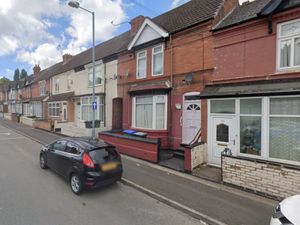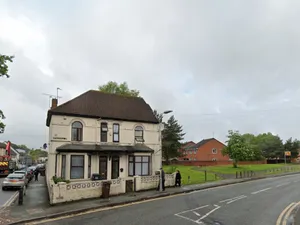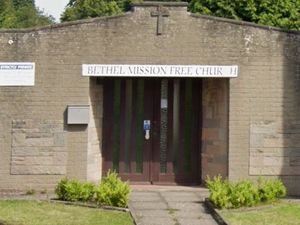Revealed: The Black Country areas with the fastest-growing house prices
A spring surge in house buying is about to hit the property market in the West Midlands

It comes after recent housing market reports found house prices in the region are still on the rise.
The latest figures from HM Land Registry show that the West Midlands saw the greatest monthly rise in house prices nationally in December with a movement of 2.6 per cent from November to £238,238
The average UK house price hit a record high of £276,759 at the start of 2022, according to Halifax's latest house price index. The West Midlands is significantly cheaper at £234,421 – up 9.6 per cent on the year.
The latest Nationwide house price index showed that the wider housing market had made the strongest start to the year in almost two decades. Annual house price growth increased to 11.2 per cent in January, from 10.4 per cent in December.
Rightmove's latest house price index found nationally the price of property coming to market rose by 2.3 per cent this month (£7,785) to a record of £348,804. It was the biggest monthly jump in pounds recorded by Rightmove in more than 20 years.
Property group Savills expects the average West Midlands house price to rise by 15.9 per cent by 2026 to £306,784 ahead of the national rise of 13.1 per cent. It predicts a rise of four per cent over the course of 2022 from £264,697 at the end of 2021.
Property consultancy JLL predicts that house prices in Birmingham are expected to rise more than any city in the UK over the next five years. with the the average value of a home in the city rising by 4.9 per cent per year and rental values rising by 2.8 per cent.
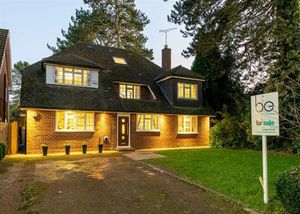
It latest Residential Forecast 2022-2026 report suggests that this year's Commonwealth Games will be a key driver behind the growth as it will thrust the city onto the world stage and bring thousands of high-earning jobs to the area. The impending arrival of HS2 is also a factor.
Research by Birmingham-based estate and lettings agent Barrows and Forrester, has revealed that now is the right time to list your home on the market in order to take advantage of the spring surge in market activity that it believes is about to hit the property market.
Barrows and Forrester analysed residential transactions across England and Wales by month over the last five years, looking at the average number of transactions to take place in order to reveal when the market was at its busiest for home buyer activity.
The research shows that based on the number of homes sold over the last five years, March is the second busiest month of the year, with 63,547 transactions completing as those sales agreed before the Christmas break finally make it over the line.
When it comes to buyer and seller activity throughout the new year, June is the busiest month for the property market, with an average of 68,546 transactions completing in a single month.
While summer may seem a long way away, it takes an average of four to six months to sell a home from first listing on the market to reaching completion.
This means that this record level of transactions actually comes as a result of the spring surge in buyer demand and so those looking to take advantage should be thinking about listing their home in the coming weeks in order to do so.
Managing director of Barrows and Forrester James Forrester said: “What we generally find each year is that January is quiet as we return from the Christmas break and there isn’t a great deal of intent from both buyer and seller.
"However, we do see an uplift in sales around March from those that were agreed prior to the Christmas break and have finally reached completion.
"March also tends to mark the start of the spring surge with a great deal of buyers and sellers entering the market having spent the first few months of the year getting their house in order.
"This heightened level of activity then results in a notable spike in the number of transactions completing around June and this trend tends to remain for the remainder of the year.”
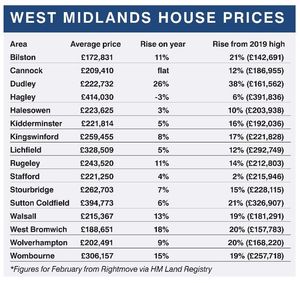
Nick Berriman, director at Berriman Eaton, which has offices in Tettenhall, said 2021 had been an "absolutely phenomenal" year for house sales.
"Nowhere in the Black Country are prices stagnating or going down, but some areas are increasing at a more rapid pace than others," added Mr Berriman, who said Wolverhampton had seen an overall 10 per cent increase over 12 months. Even in the less popular areas there had been a seven per cent rise.
He said that the most competitive area of the market on the west side of Wolverhampton was in properties of between £350,000 to £600,000
"There is a steady number of people registered interest in that price range, but there is a marked shortage of supply. Supply and demand are out of balance with much more demand than supply _ that is a nationwide problem.
"First-time buyers are funding it very hard to buy now.
"There is a massive degree of demand but supply is stunted. It is a difficult market to buy in but a fantastic market to sell in.
He said that across the conurbation the demand was very strong with the most exclusive parts of Tettenhall, Wightwick, Finchfield and Compton the real hot spots.
James Forrester said: “There’s certainly been no let up in the sheer volume of buyers swamping the market and we continue to see high numbers fighting it out for a very limited level of stock, the result of which is an inevitable boost to property values.
"However, we’re also seeing sellers pre-empt this high demand and enter the market at a far higher price point to take advantage of this buyer desperation and this has pushed asking prices up at their highest monthly rate in over two decades.”
Research by the estate and lettings agent has revealed which Birmingham commuter hubs have seen house prices soar during the pandemic, as Britain’s property market boom shows no signs of slowing in 2022.
Barrows and Forrester analysed house price growth across the areas and how the market has performed during the pandemic.
The research shows that with work from home restrictions leading to a drop in demand for city centre properties, Birmingham has largely underperformed when compared to its surrounding commuter belt.

In the last year, Birmingham house prices have climbed by eight per cent and they are up 13 per cent when compared to pre-pandemic levels. Just Solihull, Walsall and North Warwickshire have seen a lower rate of house price growth both annually and when compared to 2019.
Mr Forrester said: “It’s quite remarkable that the Birmingham market could be described as underperforming based on a 13 per cent increase in property values during the pandemic. This is still a phenomenal rate of growth and perhaps all the more impressive given that demand for city centre living has taken a hit due to Covid restrictions over the last two years.”
Lichfield has seen the strongest pandemic performance. House prices in the city have climbed 13.6 per cent in the last year alone. The average home has also increased by 22.1 per centwhen compared to pre-pandemic levels and at an average of £303,201, it comes in 42 per cent above the Birmingham average.
Sandwell has also seen a sharp up lift where property values are concerned, up 12 per cent annually, with Dudley up 10 per cent.
James Clelland, branch manager of Barrows and Forrester’s Lichfield branch, said: “As has been the case in many major cities, the pandemic has spurred homebuyers to look further afield for larger homes and more green space and this has certainly been a driving factor behind the meteoric market performance seen in Lichfield.
"At the same time, they remain within a very commutable distance to Birmingham and so they really have benefited from the best of both worlds in this respect. As a result, properties in Lichfield have become extremely sought after and a lack of stock to meet this demand has also helped drive up local market values.”
The housing market has been through an unprecedented boom over the course of the pandemic. With the shift to flexible, remote and home working, homebuyers have rushed to buy larger properties in picturesque and rural locations outside of cities and large towns.
Simon Dodds, branch manager for Halls in Whitchurch, says other factors increasing home buying were the Government’s stamp duty holiday and historically low-interest rates.
Mr Dodds says a rise in staycations in the UK also helped drive the thriving property market in rural areas.
Peter Daborn, residential sales director at Savills in Shropshire, says: "What we have seen is a total shift in the market and people's buying priorities with the requirement of more space being in the most demand.
"It's worked well with places like Shropshire where there are lots of rural properties with more space and they are away from built-up areas.
"Shropshire has definitely had more of a spotlight on it than ever before. We used to refer to Shropshire as a 'hidden gem' whereas now I feel it has not as hidden as it used to be. It has definitely had a lot more coverage when talking about places to live."
Homebuyer activity at the start of the year has been strong, according to Rightmove and Zoopla, with record numbers of valuation requests and property searches suggesting the pandemic-driven ‘race for space’ continues to play out, yet it remains to be seen how much of this early home mover activity translates through to sales. Rising interest rates and concerns about inflation and the growing cost of living may already be having an impact on consumer sentiment, resulting in buyers agreeing to pay less for properties.
Rob Houghton, chief executive of reallymoving, says: “Falls in the average house price in March and April could indicate the beginning of a slowdown in the property market, but the rate of growth we’ve seen since the summer of 2020 couldn’t continue indefinitely and a return to a more stable footing would be good news for first-time buyers in particular.
“While growth in earnings fails to keep pace with the cost of living, worries about the inevitable squeeze on household finances will make some people think twice about moving and reluctant to take on more debt, which is why the shortage of homes for sale across the board could be an ongoing problem in 2022 – especially considering many of the people who would have sold this year brought their move forward to benefit from the stamp duty saving. Much will depend on the volume of new listings we see hitting the market this spring and the speed at which lenders push up the cost of fixed rate deals.”

